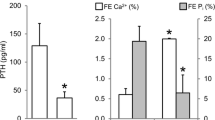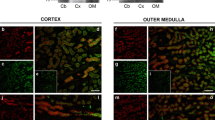Abstract
In order to further characterize Cl− transport of the thin ascending limb of Henle's loop (TAL), we observed the effects of glutaraldehyde on Na+ and Cl− transport in hamster TAL perfused in vitro. We found that 0.1 mol/l glutaraldehyde added either to the lumen or to the bath caused a rapid irreversible reversal of the NaCl diffusion potential. This was mainly accounted for by an inhibition of Cl− permeability (10−7 cm2 s−1) from 93.51±8.39 to 14.89±3.91 (P<0.01,n=9). By contrast, Na+ permeability changed little from 34.18±3.27 to 26.56±2.74 (P<0.01,n=6). Glutaraldehyde treatment abolished the halogen-permselectivity of the TAL as determined by the voltage deflection seen upon ionic substitution. Permeabilities for Cl−, Br−, I−, and SCN− relative to Na+ were changed from 3.16±0.20, 3.22±0.19, 2.97±0.26 and 4.36±0.36 to 0.38±0.07, 0.35±0.06, 0.36±0.07 and 0.58±0.05, respectively. The effect of glutaraldehyde on the NaCl diffusion potential was dose-dependent in the range from 10−5 to 10−1 M. The effect was reversible at concentrations lower than 10−3 M. Glutaraldehyde did not affect the NaCl diffusion potential of the long-loop descending limb. These observations constitute additional evidence that the mechanism of Cl− transport across the TAL is different from that of Na+ transport. Glutaraldehyde might inhibit Cl− transport in the TAL by cross-linking amino acid residues of the proteins essential for halogen transport across this segment.
Similar content being viewed by others
References
Barry PH, Diamond JM (1970) Junctional potentials, electrolyte standard potentials and other problems in interpreting electrical properties of membrane. J Membr Biol 3:93–121
Burg MB, Grantham J, Abramow M, Orloff J (1966) Preparation and study of fragments of single rabbit nephron. Am J Physiol 210:1293–1298
Hogg RJ, Kokko JP (1982) Comparison between the electrical potential profile and the chloride gradients in the thin limbs of Henle's loop in rats. Kidney Int 14:428–436
Imai M (1977) Function of the thin ascending limb of Henle of rats and hamsters perfused in vitro. Am J Physiol 232:F201-F209
Imai M (1984) Functional heterogeneity of the descending limbs of Henle's loop. II. Interspecies difference among rabbits, rats, and hamsters. Pflügers Arch 402:313–401
Imai M, Kokko JP (1973) Relative permeability of the thin ascending limb of Henle (tALH) to various ions (Abstract). Proc 6th Ann Meeting Am Soc Nephrol, Washington DC, USA
Imai M, Kokko JP (1974) Sodium, chloride, urea, and water transport in the thin ascending limb of Henle. Generation of osmotic gradients by passive diffusion of solutes. J Clin Invest 53:393–402
Imai M, Kokko JP (1976) Mechanism of sodium and chloride transport in the thin ascending limb of Henle. J Clin Invest 58:1089–1097
Imai M, Kusano E (1982) Effects of arginine vasopressin on the thin ascending limb of Henle's loop of hamsters. Am J Physiol 243:F167-F172
Imai M, Hayashi M, Araki M (1984) Functional heterogeneity of the descending limbs of Henle's loop. I. Internephron heterogeneity in the hamster kidney. Pflügers Arch 402:385–392
Imai M, Hayashi M, Araki M, Tabei K (1984) Function of the thin limbs of Henle's loop. In: Robinson RR (ed) Nephrology. Springer, Berlin Heidelberg New York Tokyo, pp 196–207
Kanaseki N (1982) Characteristics and mechanism of action of chemical fixatives. In: Akabori H (ed) Methods of electronmicroscopy in medicine and biology. Maruzen, Tokyo, pp 106–134 (in Japanese)
Kielland J (1937) Individual activity coefficients of ions in aqueous solutions. J Am Chem Soc 59:1675–1678
Kondo Y, Imai M (1987) Effect of glutaraldehyde on renal tubular function. I. Preservation of vasopressin-stimulated water and urea pathways in rat papillary collecting duct. Pflügers Arch 408:479–483
Marsh DJ, Martin CM (1977) Origin of electrical PD's in hamster thin ascending limbs of Henle's loop. Am J Physiol 232:F348-F357
Robinson RA, Stokes RA (1970) Electrolyte solution, 2nd edn. Butterworths, London
Sailling N, Siggard-Anderson O (1971) Liquid-junction potential between plasma or erythrolysate and KCl solution. Scand J Clin Lab Invest 28:33–40
Spray DC, White RL, Carvalho A, Bennett MVL (1983) Internal pH and transjunctional voltage control gap junctional conductance by separable mechanisms (Abstract). Proc Int Union Physiol Sci 15:503
Tabei K, Imai M (1986) Permselectivity for cations over anions in the upper portion of descending limbs of Henle's loop of long-loop nephron isolated from hamsters. Pflügers Arch 406:279–284
Author information
Authors and Affiliations
Rights and permissions
About this article
Cite this article
Kondo, Y., Imai, M. Effect of glutaraldehyde on renal tubular function. Pflugers Arch. 408, 484–490 (1987). https://doi.org/10.1007/BF00585073
Received:
Accepted:
Issue Date:
DOI: https://doi.org/10.1007/BF00585073




